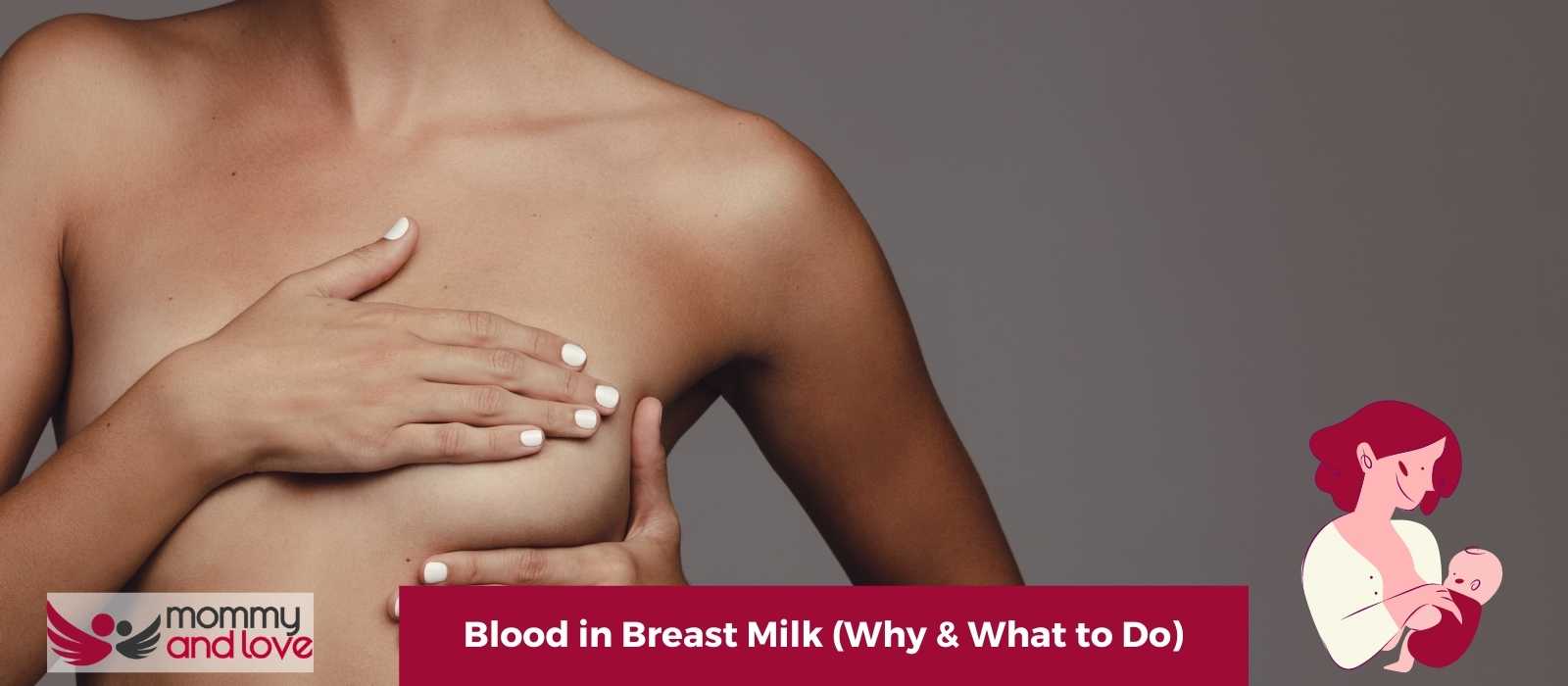Many women do experience blood in breast milk, especially first-time moms. Bloody discharge can be a frightening and confusing experience, but blood in breast milk is a common problem when breastfeeding and usually not a sign of a serious problem.
If you notice blood in your breast milk, it is important to determine the source of the blood as soon as possible. There are a few potential sources of blood in breast milk, and each one requires a different course of action.
Color of Breast Milk
In most cases, the bloody breast milk will clear up on its own within a few days.
For most women, blood-stained milk is a common occurrence. As they continue breastfeeding, mothers should learn about the possible reasons for containing blood in their breastmilk. The blood in the breast milk could be due to a variety of reasons, but what’s important is that breast milk doesn’t cause any harm to her and the baby.
Here are the most common cause why there is blood in breastmilk and things you can try to see if it is something that goes away on its own or if you should consult a lactation consultant or your healthcare provider if you are concerned about the possibility of breast cancer.
What Causes Blood in Breast Milk?
Many women find blood in their breast milk and wonder what to do or if it is a serious medical condition. During a mother’s breastfeeding journey, blood in your breast milk is fairly benign and isn’t cause for concern. It is completely normal for blood in breast milk.
Cracked or Damaged Nipples
One common source of blood in breast milk is bleeding from a cracked or damaged nipple. This can be caused by a number of things, such as a cracked nipple, skin irritation, or a blocked milk duct. If you notice blood present in your breast milk (from pumping or when baby spits it out) and it is coming from your nipples, you can try the following remedies:
-Apply warm compresses to your breasts for a few minutes before breastfeeding
-Gently express some milk from your breasts and discard it
-Take a hot shower before breastfeeding
-Use a nipple shield to help protect your nipples from friction
Broken Blood Vessels or Capillaries

Your breasts have small delicate blood vessels which can be easily damaged. When these small blood vessels break, a little blood from them can leak into milk.
When pumping it’s vital to be careful and not pump too hard, or if hand expressing be gently when squeezing to release your milk as you can damage the milk making cells.
If your baby has swallowed blood, don’t panic! It’s normal, natural and unless it’s large volumes it’s little to worry about.
Rusty Pipe Syndrome
This is a condition which is where the colour of your milk is ‘rusty’ (pink, orange, blood-stained). It happens in the early stage as your early milk (colostrum) mixes with a small amount of blood. It’s common and especially so for first-time mothers.
This is not dangerous, is temporary and usually only lasts a few days. It normally clears up once your mature milk comes in.
Mastitis or Clogged Milk Ducts
Mastitus is clogged milk ducts and can happen from an infection which can lead to swelling, pain, redness and even fever in some cases.
It’s usually triggered by a build-up of milk in the breasts. This could be because of missed feeds or your baby not latching on properly. The condition is treatable with rest, hydration, and pain relief.
Benign Intraductal Papilloma
Another reason for blood in breast milk is due to a crack or injury sustained during delivery called “benign intraductal Papilloma”.
This type of papillomatosis predominantly affects the blood coming from the right breast or both nipples.
These non-cancerous damaged nipples are small but can affect a large portion of the milk ducts in the breasts, or even branch out to nearby lymph nodes or the skin around the nipples.
Sometimes your baby may pass dark bowel motions or spit up blood-stained milk as a result of the baby drinking blood-stained breastmilk.
Fortunately, these are only the occasional occurrence and not something to worry about.
Breast Cancer
In very very rare cases, if you have a large lump it might be a symptom of breast cancer. However, we should stress this is very very rare! If you do suspect a cancerous lump, then seek immediate medical advice.
Signs of blood in breast milk
Blood in breast milk can be scary, but it’s actually pretty common. Here are some signs that you might have blood in your breast milk:
1. A change of color. This can happen when your breasts are engorged or your nipples are cracked—the blood mixes with the milk and turns it pink. It might also look brownish or rust-colored, depending on how long it’s been since you’ve let down into your baby’s mouth.
2. Some blood in your baby’s stools. If you’re seeing blood in your baby’s diaper, it might just be from a cracked nipple or a cut or abrasion inside your baby’s mouth.
Although blood in breast milk can be alarming, it is often nothing to worry about.
Is It Ok if Blood Gets in Breast Milk?

It’s usually not a sign of anything harmful, and it won’t hurt your baby.
Blood from cracked nipples of a mother’s breast is normal, and it’s really nothing to worry about. Sometimes blood gets in your breast milk when you’re breastfeeding your baby and their latch isn’t quite right.
It may happen if your baby bites down on your sore nipples or if there’s a nick from a nipple piercing. The blood can also come from other causes, like mastitis (an infection of the breast tissue).
In most cases, the blood in your breast is undetectable by both you and your baby, but sometimes the blood may change the color of the milk slightly. If this happens, there’s no need to worry—you continue feeding and your baby won’t mind!
Is It Ok to Feed the Baby With Bleeding Nipples?
Yes, it’s definitely okay to feed a baby with breast milk that has a little bit of blood in it. In fact, if you stop nursing while your nipples are damaged, it will only make the problem worse. The best way to heal nipple wounds is to continue nursing.
Is Pink Breastmilk Normal?
While pink or red-coloured breastmilk can look alarming, it’s actually quite common and does no harm to your baby. It’s often caused by blood in the milk ducts, which is normally harmless, and may only last a day or two so immediate medical attention is not needed.
Why Does My Breast Milk Turn Pink?
The colors in your breast milk can be affected by a variety of factors from the food you consume to even the time of day and your breast stimulation. babies should have a continued milk supply, especially during the first months of their life.
First of all, pink breast milk similar to food dyes is just perfectly normal. Noticeable paint pink color nipples appear after you pumped milk. This is a common side effect of breast pumping, and it is completely harmless. It’s perfectly healthy, and the cause of it has nothing at all to do with anything in your diet or lifestyle.
It’s just part of what happens when you pump—as long as you’re using a breast pump that’s designed for breastfeeding and pumping.
Can I Feed My Baby Pink Milk?
It is safe to continue breastfeeding even if your milk has turned pink, as there is no evidence to suggest that pink breastmilk poses a danger to babies. Pink breastmilk is totally normal.
In short: pink breastmilk isn’t anything to worry about. If the color bothers you (some moms just like things to be a certain way), try not to stress too much—it’ll settle down in a day or two!
Is It Normal to Bleed While Pumping Milk?
It’s totally normal and ok to bleed while pumping milk. It happens when your breasts are engorged or overfull. When that happens, it can lead to cracked nipples and bleeding if you continue to pump.
The best thing to do is stop pumping and feed your baby right away.
That will help drain out any excess milk, which will make it less likely that your nipples will crack. And no need to worry—even if you have some blood in your milk, it’s usually not enough to be harmful to your baby.
What to do for bleeding nipples when pumping?
Bleeding nipples are a common side effect of breast pumping. The skin on your nipples is very sensitive, and it can be easily torn when using a breast pump. There can be many causes for this, but the most common include:
* An ill-fitting pump flange
* Too much suction
* Pumping too often or too long for frozen milk storage may damage tiny blood vessels in the breast (you should pump no more than every 2-3 hours, and for no more than 20 minutes each time)
* Pushing the pump flange in too far (make sure it’s only touching the areola and not the nipple)
There are several things you can do to stop the bleeding and make pumping more comfortable. First, you may want to try different breast shields and make sure that you are using the right size for your breast. Try applying lanolin ointment or a similar product to them before pumping. You can also try using a breast pump with larger flanges, as this may reduce the damage done to your nipples by the suction. Resolving these issues will help with your pumping as well.
Take Away on Pink Breast Milk When Pumping
When it comes to breastfeeding, the color of your milk will often change. The good news is that pink breast milk is usually not a sign of a problem and won’t harm your baby as long as you continue nursing.
If you’re seeing blood in your breast milk, it’s best to know the cause and things to do to so feed your baby right away. While bleeding nipples are a common side effect of pumping, there are several things you can do to make it more comfortable. If you think there might be something else going on with your breast milk, talk to your doctor or health care provider about it!

This article was written by Sandra Baker – full time writer and the mother of four amazing kids (including twins!)
She’s also a breastfeeding counselor and has spent years helping new parents learn how to care for their children. When she’s not writing or caring for her children, Sandra likes to spend time reading and taking walks with her husband.




